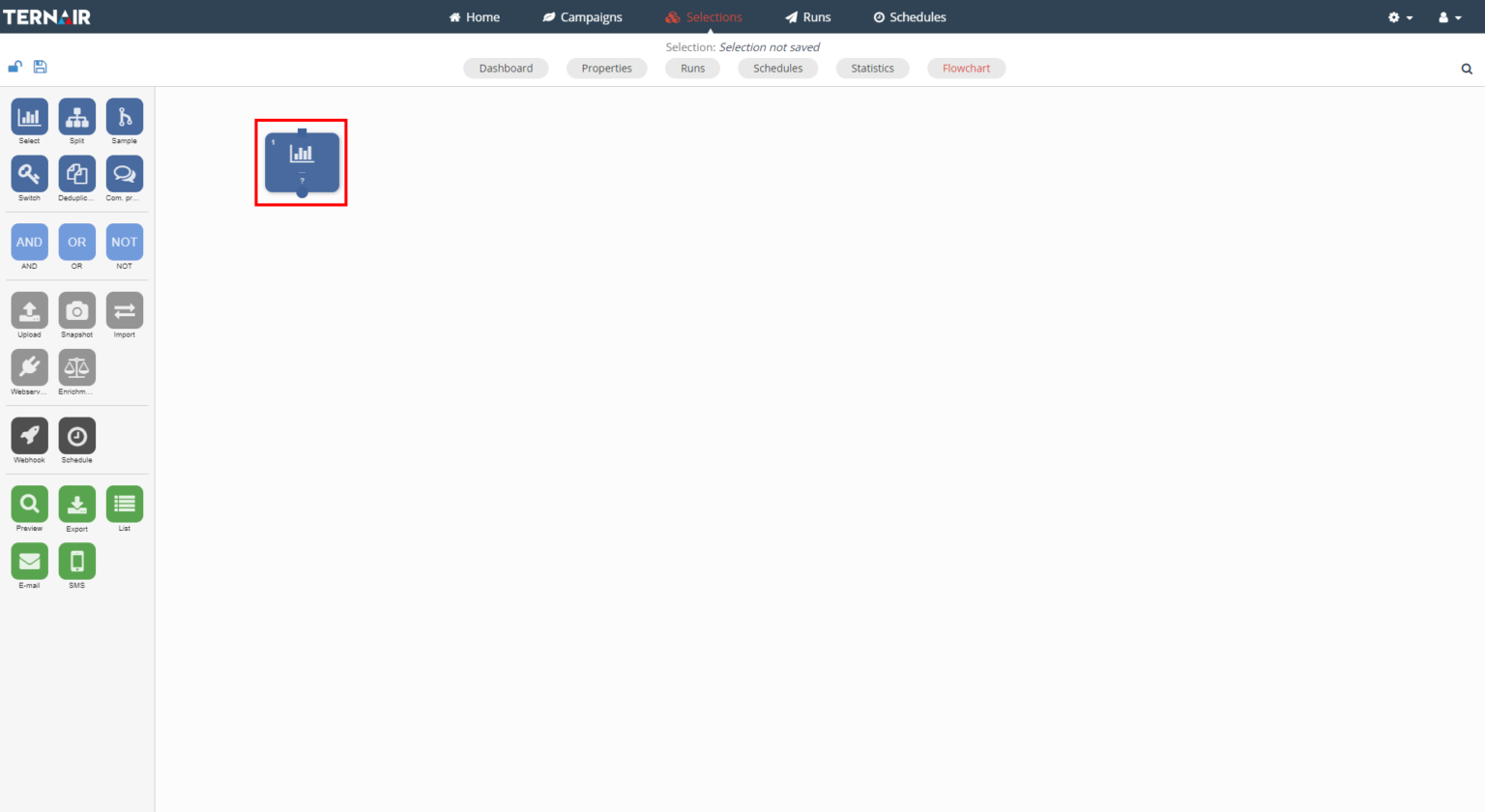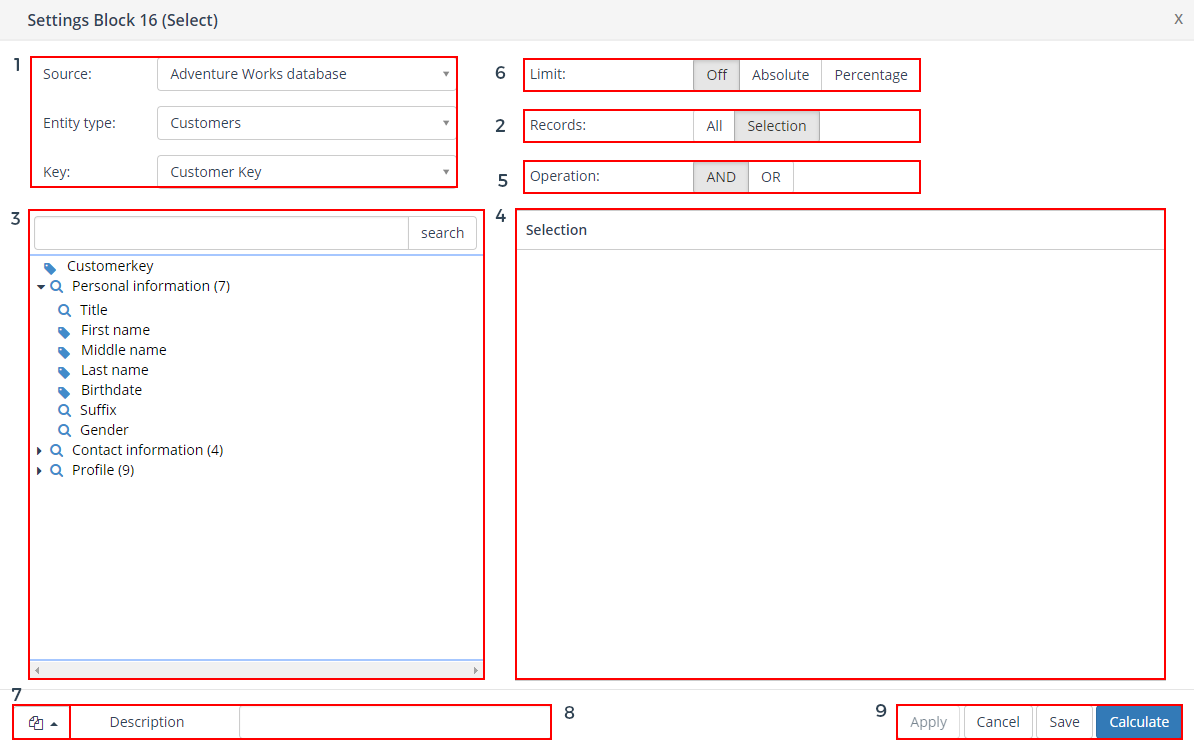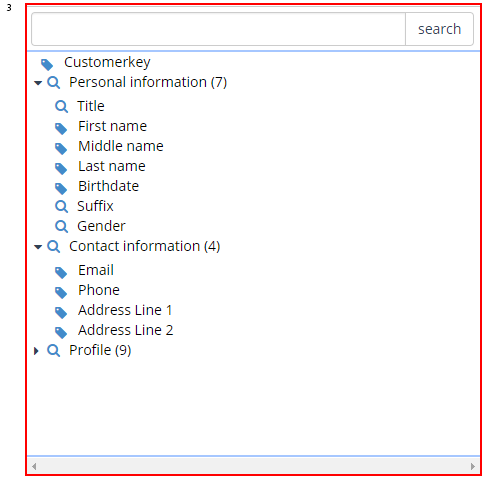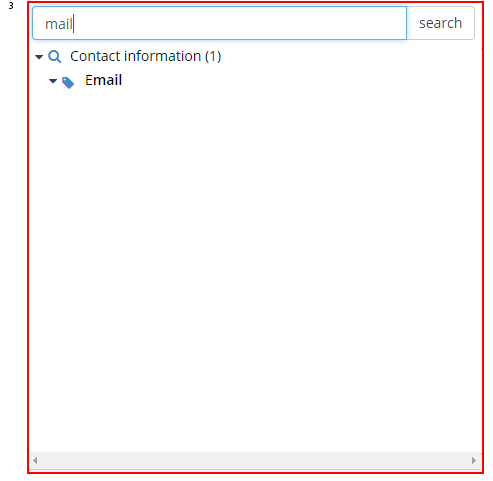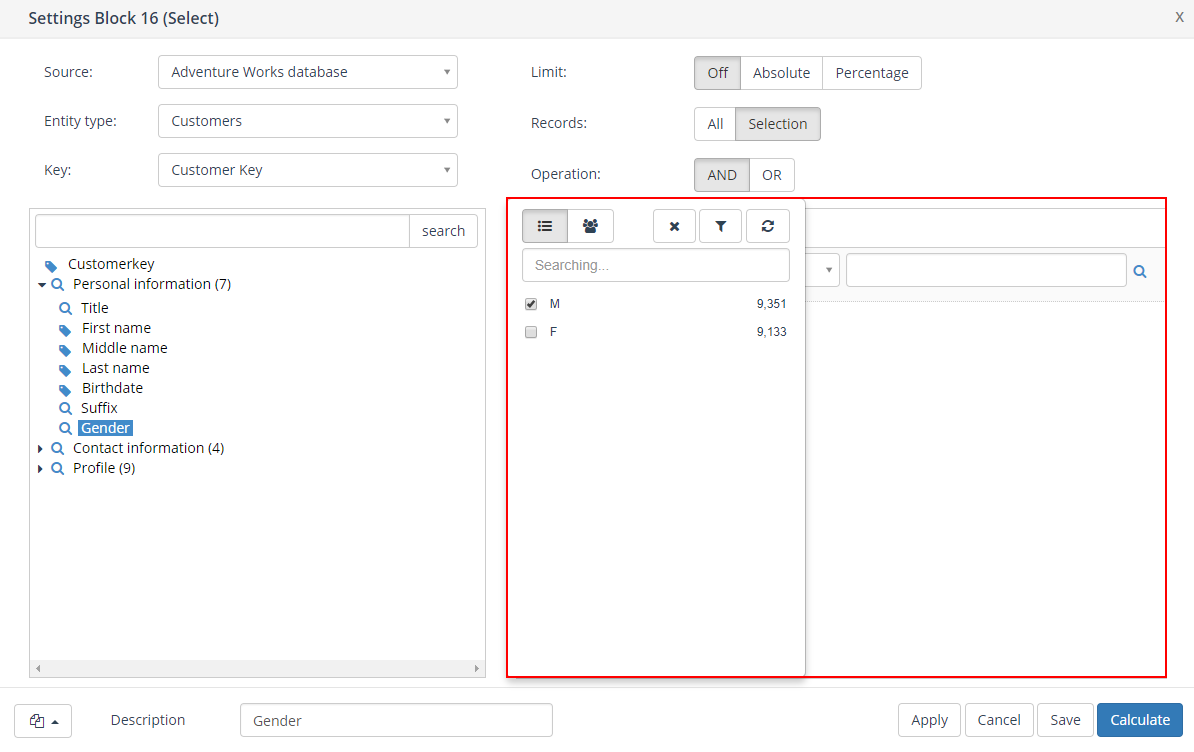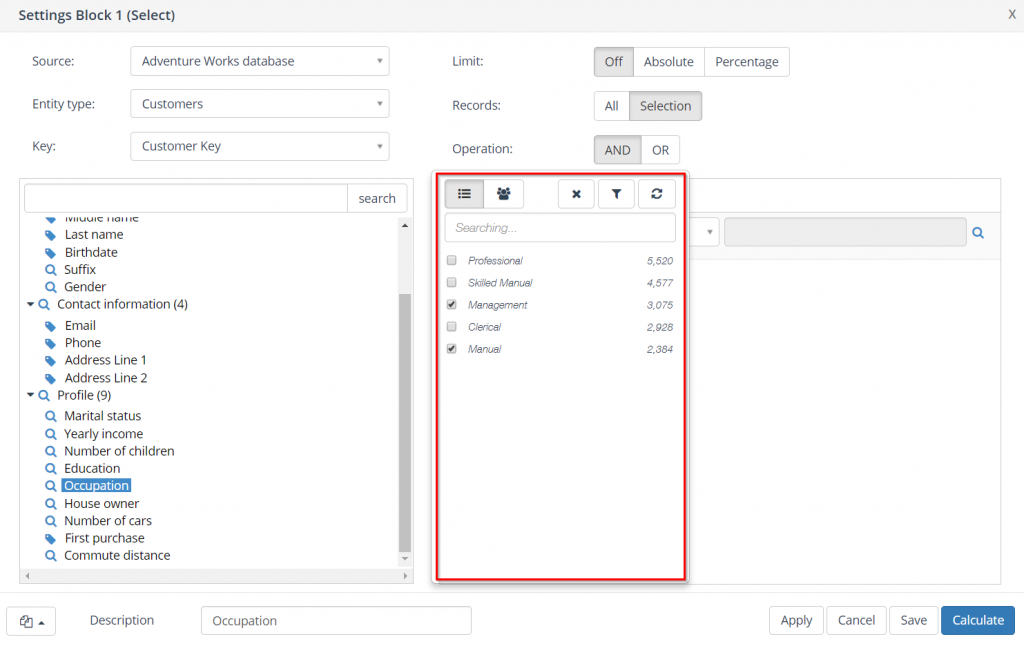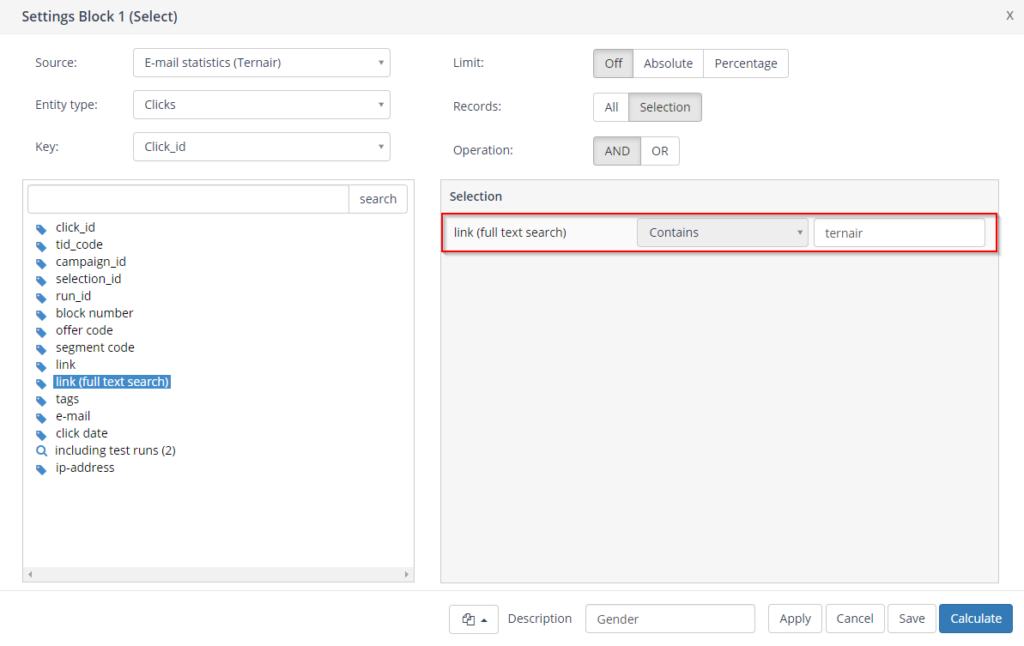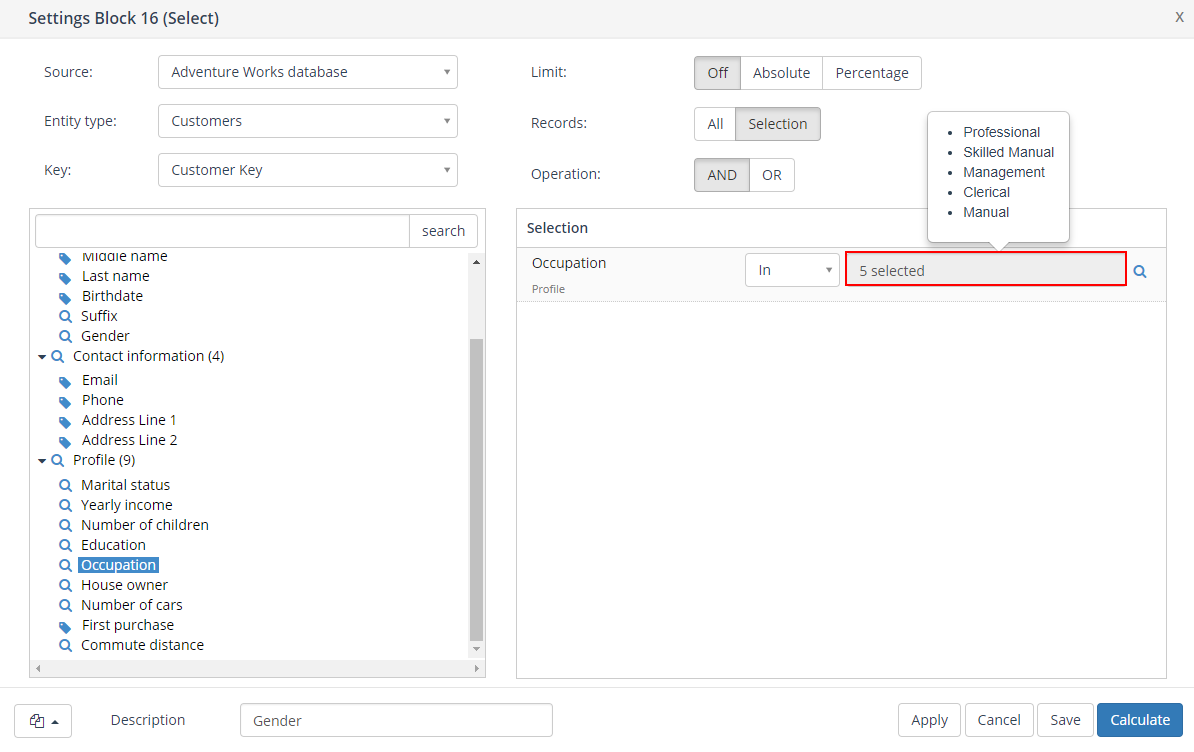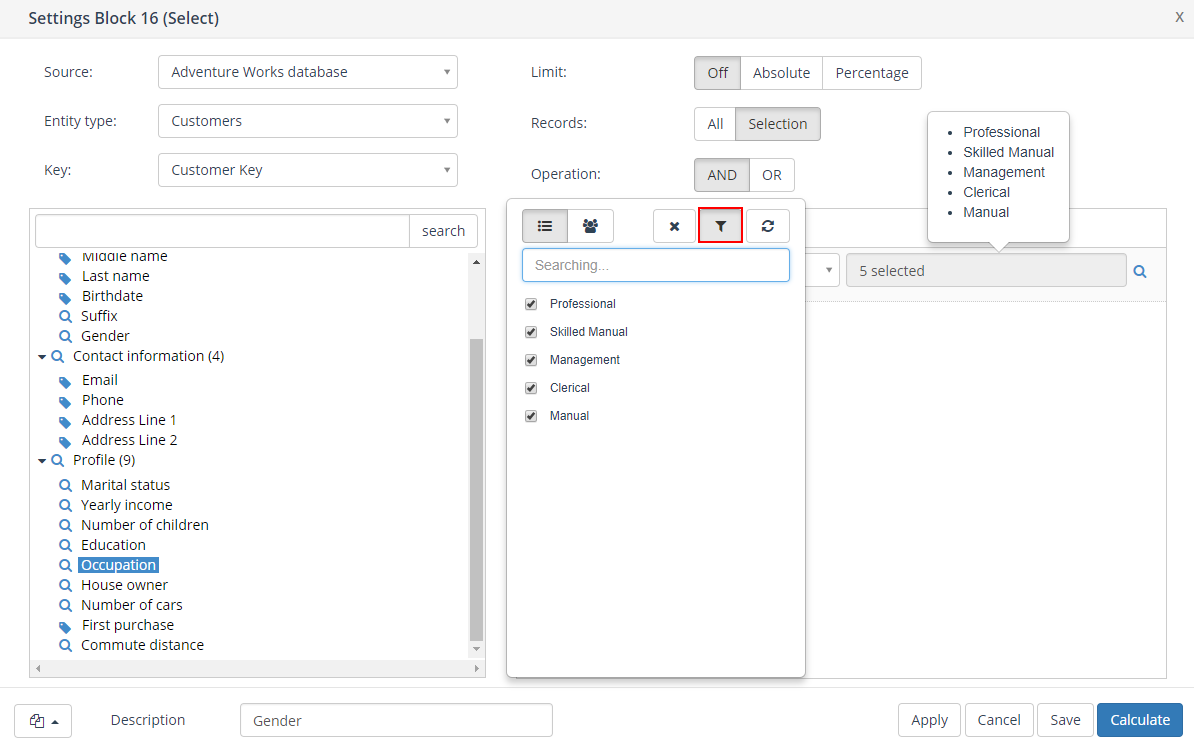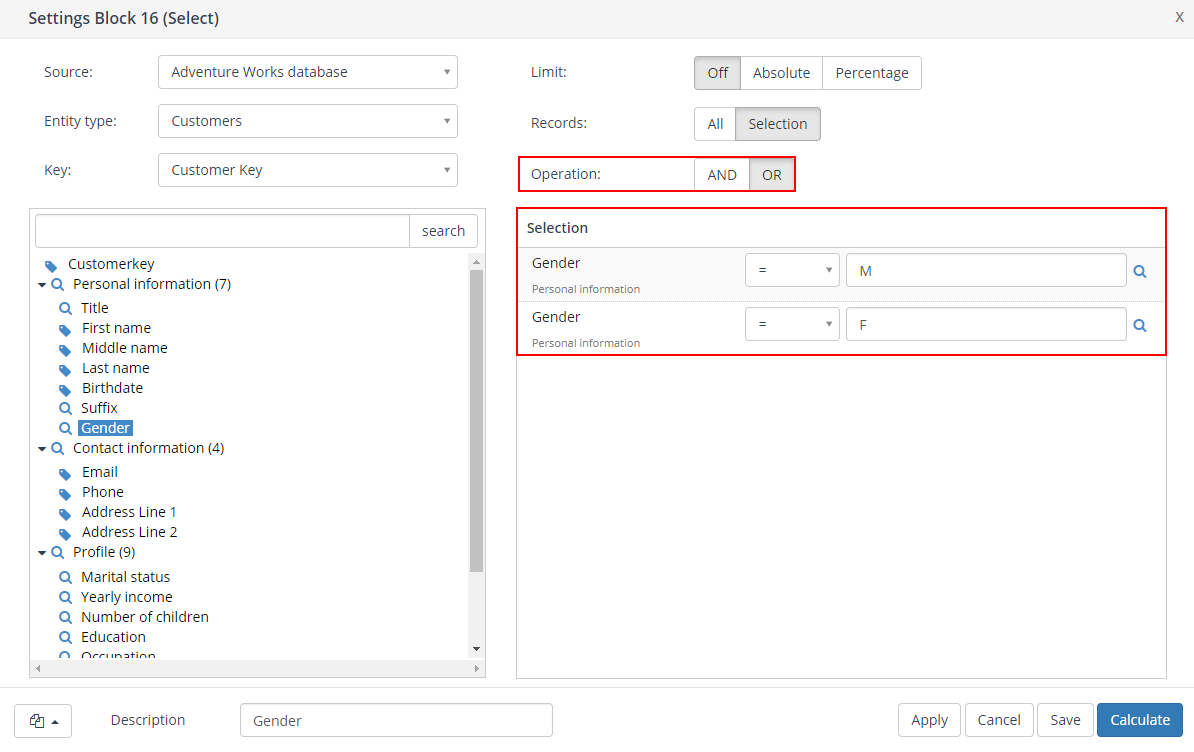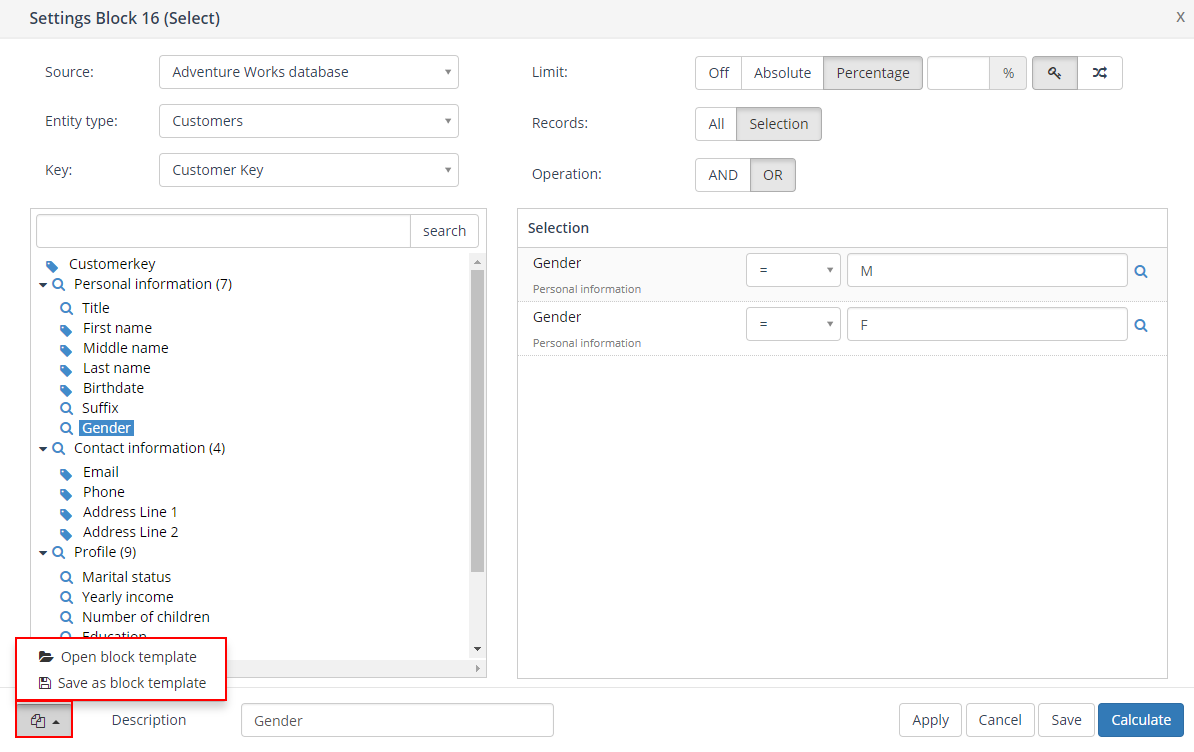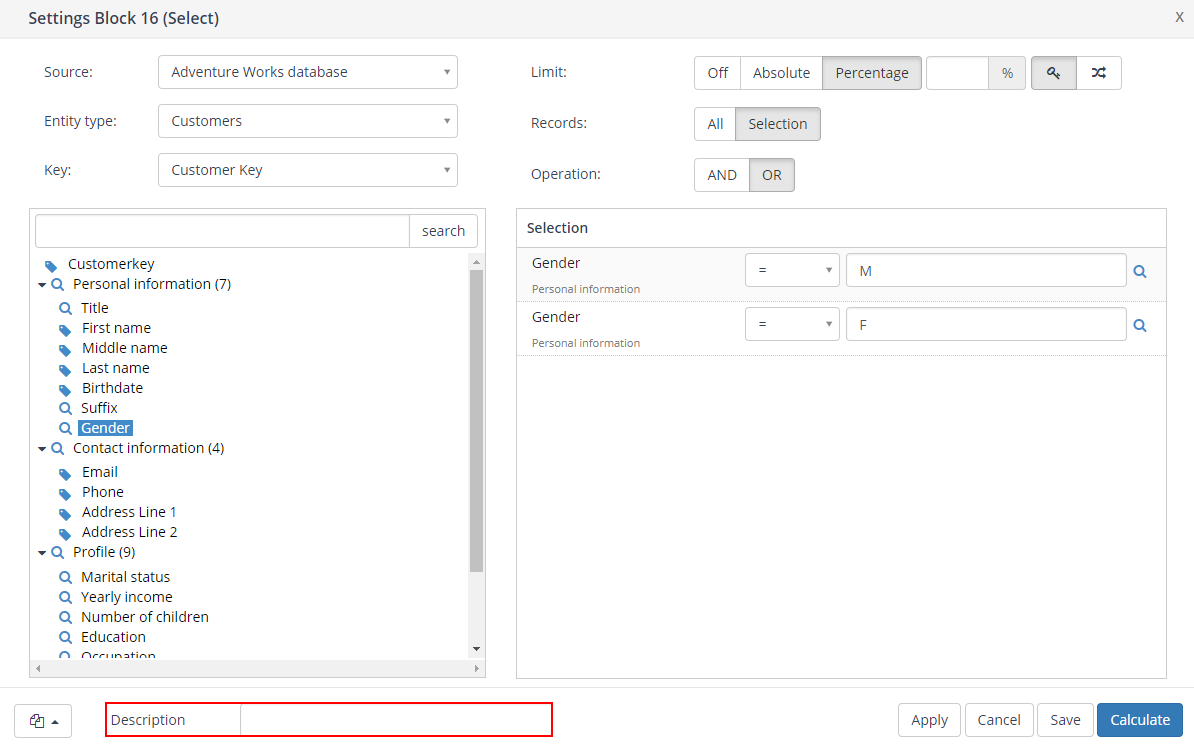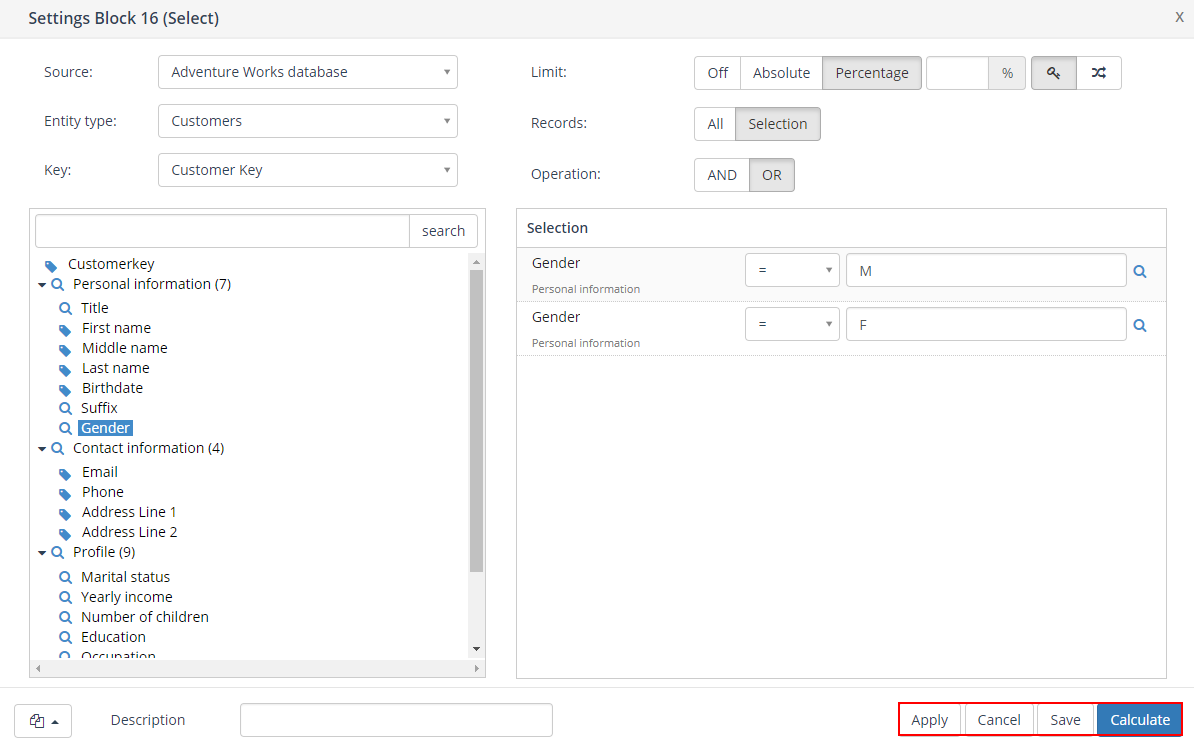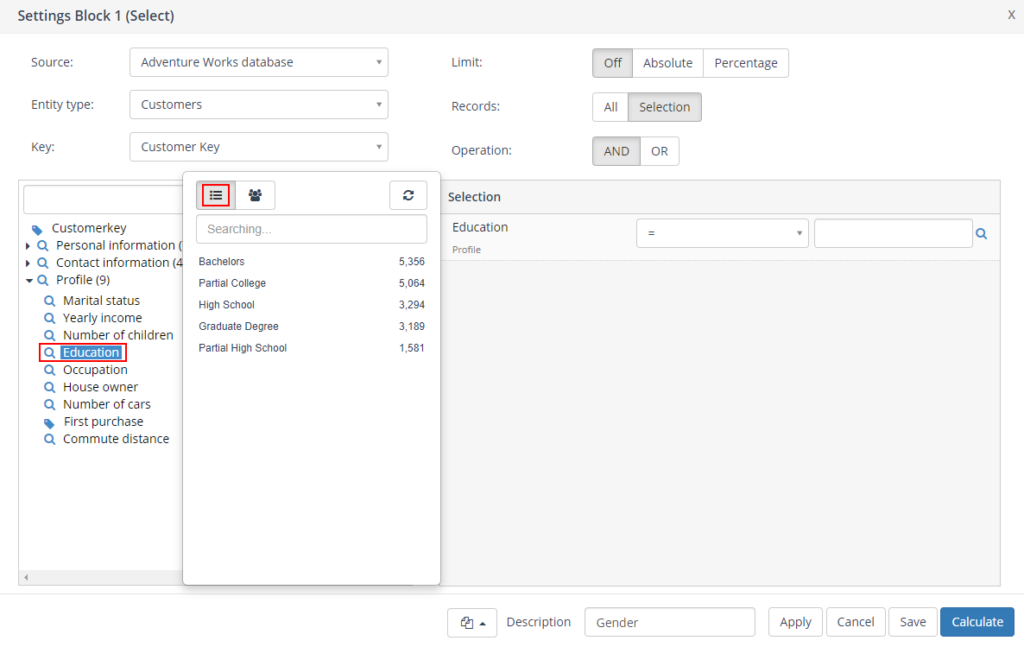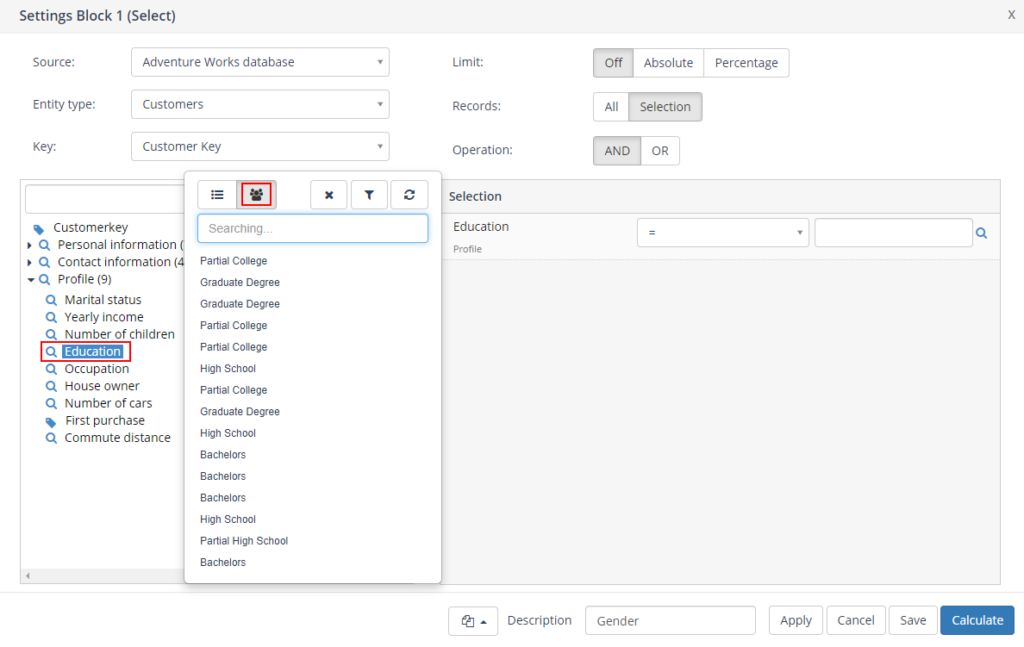With a 'Select' block you can select your target group.
Drag a selection block to the worksheet. Double-click the block to open the settings.
The following screen is displayed:
Source/ Entity Type/ Key
| Description | Example |
|---|
Source | Select which data source you want to select | Marketing database |
Entity type | Choose which data group (table) you want to select from | NAWTE |
Key | Choose which data to use as key | Account_id, email |
First, select a resource. The available sources depend on Ternair's settings. Based on the selected source an entity can be selected, for example NAWTE data (name, address, city, phone or e-mail address), contacts or e-mail statistics. Then select which key the selection should be based on. Counts will be based on the selected key.
Records
In a selection block, you need to specify whether you want to make a selection or whether all records should be selected. The default is "Selection."
Entities search/select
This part of the screen shows the different entities available to search and select. You can search for entities in several ways: (1) by scrolling the list, (2) by expanding the entity tree, or (3) through the search field.
When you enter at least one character in the search field, the entity list is filtered based on the character(s) entered.
The search term displays results in all levels of the entity tree, both in the entities themselves and in the subsequent entity values.
In the example above, the search term 'mail' is used. The search result shows the following entity: 'Email'. Furthermore, entities are displayed whose subsequent entity values contain 'mail'. Hover the mouse over the entity to display the entity values.
Double-click on the desired entity to move it to the Selection screen on the right.
Defining Selection Conditions
In the 'Selections' section of the screen you define the conditions that an entity must meet. For the selected entity, you must define the conditions the entity must meet by choosing an operator and an entity value.
In the example below, everyone who meets the condition 'Gender' = 'Male' is selected.
When using the 'IN' operator, multiple available values can be selected.
In the example below, everyone who meets the condition 'Occupation' = 'Management' and 'Executive' is selected.
A selection statement consists of: <entity> <operator> <value>.
Entity type | Available operators | Example <entity> <operator> <value> <value>; |
|---|
Text | =, <>, Starts with, Ends with, IN (comma separated), Contains, Does not start with, Does not end with, Does not contain, Is empty, Is not empty | E-mail address contains gmail.com Label IN marketing, marketingautomation, email marketing |
Text (search) | IN, =, <> | Function IN ('Director', 'Executive' , 'Manager') |
Text (full-text search)* | Contains | Link contains subscribe |
Numeric | =, <>, >, >=, <, <=, Is empty, Is not empty, IN (Comma separated) | Number of orders >= 10 ProductID IN 1234, 9876, 4567 |
Date | =, <>, >, >=, <, <=, Is empty, Is not empty | Contact date < 23-10-2021 |
Depending on Ternair's settings, other operators and search lists with entity values are available.
Entity value | Description |
|---|
Empty field | Field in which an entity value can be freely entered. For example: Gender = Male |
Drop-down search list with available values | Search list with all available entity values. For example: 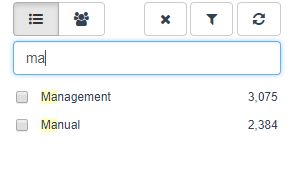
|

| Standardly the items in the preview are grouped (the value that occurs most is shown first) |

| Display a random list of fifteen records from the entity |

| Disable the filter to show all available values (deselect all options) |

| Display only the selected entity values |

| Refresh |
Full-text search
Full-text search is a method for quick(er) searching of text fields, for example URLs. This method is specifically designed to search for full words in a text string. This method requires a specific set-up and is by default implemented for the 'link (search by whole word)' field in the entity Clicks (source: E-mail statistics).
Note: Full-text search only works well on full words (example: negative). Searching on parts of a word (for example, nega) will not produce results when using full-text search.
If full-text search is performed on a word with an accent (for example, premiere), the results will contain records in which the word is written both with and without the accent. This is in contrast to a regular search, where only results for the exact search will be found.
Note: Thus, depending on the search terms used, using full-text search may produce results that differ from the result with a regular search.
Display selected values
Hover the mouse over the entity value field to display the selected value(s).

| Click the filter button in the drop-down list to display only the selected entity values. |

| Disable the filter to show all available values. |
Operation OR / AND
It is possible to name multiple selection criteria within the same entity type in a block.
When you specify multiple selection criteria, you must indicate whether you want to combine those criteria:
In the example below, using 'OR' allows you to select all records that meet the criteria 'Gender' = 'Male' or 'Gender' = 'Female' at once.
To combine AND and OR statements or combine attributes from different entity types, you must define and connect multiple selection blocks. Connectors are used to combine selection blocks (see
Combine and exclude for more information)
When using multiple selection criteria, the default is 'AND'.
Discount
In each selection block it is possible to limit the number of selection results via 'Discount'. Capping (limiting) simply means reducing the number of relations within the selection. The remaining relations are selected randomly.
The number of records meeting the selection criteria can be limited to an absolute number or to a percentage.
Select the sorting method for the records in the selection:

| Sort by current key (default) |

| Will randomly capping to sort the records before limiting the selection to a specific number or percentage. |
Please note that with random sorting, the result of using the capping function is different each time the block is calculated.
Block template
Each selection block can be saved as a template. After a selection block is saved as a template, it can be used as a template for other selection blocks. A block template can be reused by clicking 'Open block template' in the lower left corner of a selection block and selecting the template from the list.
Description
You can assign a description to a selection block. The description field is intended to give a logical description to the block. This makes the content of the block easy to recognize in the selection flowchart.
Apply/Cancel/Save/Calculate
A selection block is saved and calculated after you click the 'Calculate' button. Use the 'Cancel' button to undo your changes. Clicking the 'Apply' button will save the preliminary settings of the selection block. Finally, the 'Save' button allows you to save your changes without calculating the block (again).
Field inspector

| When the magnifying glass icon is displayed next to a field in an entity tree, a preview of the values in this field is available in the database. Click on the icon to open the preview. |
The example below shows a preview of the five courses that occur most frequently within the selected entity. The values are sorted in descending order by the number of times each value occurs. The most common value is shown first.
Please note that the value shown is the number of times this value occurs within the entity in the database. This number does not take into account the key type selected.
In addition, any selection criteria are not taken into account in the numbers shown in the preview. The numbers always refer to the contents of the entire table.
The example below shows a top 15 values within this field within the selected entity in the database.
Video
